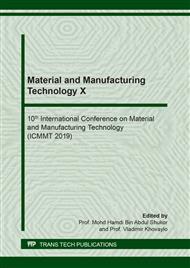[1]
I. M. Jiang, C. Y. Wang, M. S. Tsai, et al: J. Magn. Magn. Mater. Vol. 232, ( 2001), p.181.
Google Scholar
[2]
A. V. Prokof'ev, I. V. Pleshakov , E. E. Bibik , Yu. I. Kuz'min: Tech. Phys. Lett. Vol. 43, No.2, (2017), p.194.
Google Scholar
[3]
Y. Zou, Z. Y. Di, and X. F. Chen, et al: Appl. Optics. Vol. 50, No. 8, (2011), p.1087.
Google Scholar
[4]
O. A. Dotsenko , A. A. Pavlova , V. S. Dotsenko: Russian Physics Journal , Vol. 60, No.11, (2018), p. (1955).
Google Scholar
[5]
Chin-Yih Hong, Y. H. Ke, H. E. Horng, et al: J. Magn. Magn. Mater. Vol. 289, (2005), p.93.
Google Scholar
[6]
H. M. Lee, L. Horng , J. C. Wu: J. Phy. D Appl. Phys. Vol. 44,No.6, (2011), 064016.
Google Scholar
[7]
Y. Zhao, R. Q. Lv, H. Li, and Q. Wang: IEEE T. Magn. Vol. 50, No. 5, (2014), 4600107.
Google Scholar
[8]
Y. Zhao, D. Wu, R. Q. Lv, J. Li: IEEE T. Instrum Meas. Vol. 65, No. 6, (2016), p.1503.
Google Scholar
[9]
J. F. Lin, M. Z. Lee: Springer New York , 2013. Imaging Methods for Novel Materials and Challenging Applications, 3, 319 (2013). Conference Proceedings of the Society for Experimental Mechanics Series.
Google Scholar
[10]
B. Y. Ku, D. A. Horsley: A Ferrofluid Immunoassay Based on Magnetic Field-Induced Birefringence. Sensors, (2007)1089-1092.
DOI: 10.1109/icsens.2007.4388595
Google Scholar
[11]
Q. L. Chen, H. Wang, Q. W. Wang, Y. X. Pan: Plasmonics, Vol. 13, (2018), p.353.
Google Scholar
[12]
R. Karthick, K. Ramachandran, R. Srinivasan: Nanosistems: Physics, Chemestry, Mathematics, Vol. 7, No. 4, (2016), p.624.
Google Scholar
[13]
V. V. Mekhonoshin, A. Lange: Phys. Fluids. Vol. 16, No. 4, (2004), p.925.
Google Scholar
[14]
D. C. Zhang, Z. Y. Di, Y. Zou and X. F. Chen: Temperature sensor using ferrofluid thin film. Springer, Microfluid Nanofluid, 2008, DOI 10.1007/s10404-008-0371-8. (short communication).
DOI: 10.1007/s10404-008-0371-8
Google Scholar
[15]
D. Su, S. Pu, L. Mao, Z .Wang, K. Qian: Sensors. Vol. 16, No. 12, (2016), p.2157.
Google Scholar
[16]
X. Li , T. Shinshi , W. Hijikata, Y. Morimoto: Rev. Sci. Instrum. Vol. 87, No. 6, (2016), p.425.
Google Scholar
[17]
J. Chass. Ferrofluidic: electrical power generator [P]. United States Patent, US 6,489,694 B1.
Google Scholar
[18]
S. L. Pu, X. F. Chen, Z. Y. Di, T. Geng, Y. X. Xia: Chin. Phys. Lett. Vol. 24, No. 11, (2007), p.3253.
Google Scholar
[19]
M. Dai: Electric current of magnetic fluid at ordinary temperature. 2018 IEEE International Conference on Electronics Technology, Symposiums : 129-133.
Google Scholar
[20]
A. Gavili, F. Zabihi, T. D. Isfahani, J. Sabbaghzadeh. Ex. Therm: Fluid Sci. Vol. 41, No. 41, (2012), p.94.
Google Scholar
[21]
N. Mousavi, S. Kumar: J. Appl. Phys. Vol. 123, No. 4, (2018), 043902.
Google Scholar
[22]
H. L. Fu, L. Gao: Phys. Lett. A. Vol. 375, No. 41, (2011), p.3588.
Google Scholar
[23]
H. Gu, Y. H. Lan, K. M. Fan, H. M. Gu, Y. L.: Public Communication of Science & Technology. No. 10, (2013), p.117.
Google Scholar
[24]
C. Q. Chi, Z.S. Wang, P. Z. Zhao: Mechanics of ferrofluid. Beijing: Beihang university press, (1993).
Google Scholar
[25]
Robert D. Podolsky: Science, Vol. 265, No. 5168, (1994). P. 100.
Google Scholar


